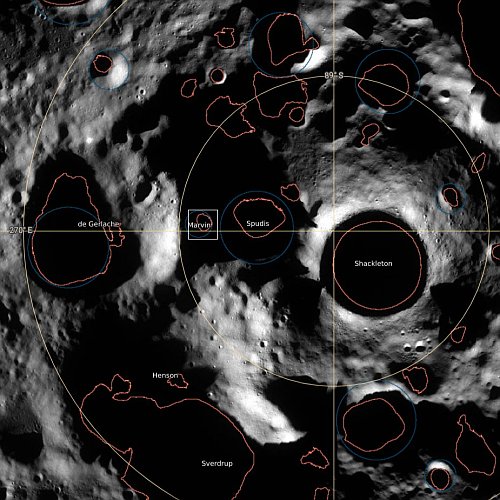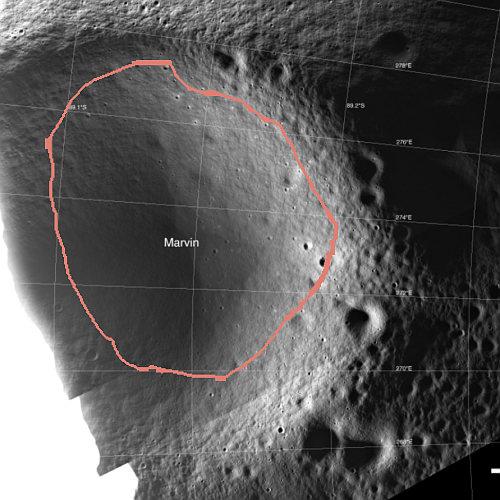No ice inside permanently shadowed crater near Moon’s south pole?

Using a camera on South Korea’s lunar orbiter Danuri, dubbed Shadowcam and designed to look into the permanently shadowed craters at the Moon’s poles, scientists have taken an image that sees into the forever dark region of one such crater.
The picture to the right, released on March 13, 2023 by the Shadowcam science team, is of the crater Marvin, located about 16 miles to the east of the south pole. The pink outline indicates the area that is thought to be permanently shadowed.
The second image to the right provides a wider view of the south pole region, with the craters labeled and outlined by the green lines. The orange lines mark permanently shadowed areas. The white box indicates the approximate area covered by the Shadowcam picture. One of the candidate landing sites for Starship, as part of NASA’s Artemis program, is the eastern rim of Shackleton, essentially at the south pole itself.
Previous data suggests that ice should be found in those permanently shadowed areas, because other orbiters have detected evidence of hydrogen there. The Shadowcam picture above however shows nothing that strongly suggests the presence of ice, unless that darker flat area on the floor of the crater is ice-infused dust. If so however, it is quite ancient and solid, based on the presence of several craters within it.
The press release makes no mention of this question, probably because the scientists are still analyzing the data. This first look however suggests the ice is not there, or is in a form that is going to require a lot of processing to extract the water from it.
On Christmas Eve 1968 three Americans became the first humans to visit another world. What they did to celebrate was unexpected and profound, and will be remembered throughout all human history. Genesis: the Story of Apollo 8, Robert Zimmerman's classic history of humanity's first journey to another world, tells that story, and it is now available as both an ebook and an audiobook, both with a foreword by Valerie Anders and a new introduction by Robert Zimmerman.
The print edition can be purchased at Amazon or from any other book seller. If you want an autographed copy the price is $60 for the hardback and $45 for the paperback, plus $8 shipping for each. Go here for purchasing details. The ebook is available everywhere for $5.99 (before discount) at amazon, or direct from my ebook publisher, ebookit. If you buy it from ebookit you don't support the big tech companies and the author gets a bigger cut much sooner.
The audiobook is also available at all these vendors, and is also free with a 30-day trial membership to Audible.
"Not simply about one mission, [Genesis] is also the history of America's quest for the moon... Zimmerman has done a masterful job of tying disparate events together into a solid account of one of America's greatest human triumphs."--San Antonio Express-News

Using a camera on South Korea’s lunar orbiter Danuri, dubbed Shadowcam and designed to look into the permanently shadowed craters at the Moon’s poles, scientists have taken an image that sees into the forever dark region of one such crater.
The picture to the right, released on March 13, 2023 by the Shadowcam science team, is of the crater Marvin, located about 16 miles to the east of the south pole. The pink outline indicates the area that is thought to be permanently shadowed.
The second image to the right provides a wider view of the south pole region, with the craters labeled and outlined by the green lines. The orange lines mark permanently shadowed areas. The white box indicates the approximate area covered by the Shadowcam picture. One of the candidate landing sites for Starship, as part of NASA’s Artemis program, is the eastern rim of Shackleton, essentially at the south pole itself.
Previous data suggests that ice should be found in those permanently shadowed areas, because other orbiters have detected evidence of hydrogen there. The Shadowcam picture above however shows nothing that strongly suggests the presence of ice, unless that darker flat area on the floor of the crater is ice-infused dust. If so however, it is quite ancient and solid, based on the presence of several craters within it.
The press release makes no mention of this question, probably because the scientists are still analyzing the data. This first look however suggests the ice is not there, or is in a form that is going to require a lot of processing to extract the water from it.
On Christmas Eve 1968 three Americans became the first humans to visit another world. What they did to celebrate was unexpected and profound, and will be remembered throughout all human history. Genesis: the Story of Apollo 8, Robert Zimmerman's classic history of humanity's first journey to another world, tells that story, and it is now available as both an ebook and an audiobook, both with a foreword by Valerie Anders and a new introduction by Robert Zimmerman.
The print edition can be purchased at Amazon or from any other book seller. If you want an autographed copy the price is $60 for the hardback and $45 for the paperback, plus $8 shipping for each. Go here for purchasing details. The ebook is available everywhere for $5.99 (before discount) at amazon, or direct from my ebook publisher, ebookit. If you buy it from ebookit you don't support the big tech companies and the author gets a bigger cut much sooner.
The audiobook is also available at all these vendors, and is also free with a 30-day trial membership to Audible.
"Not simply about one mission, [Genesis] is also the history of America's quest for the moon... Zimmerman has done a masterful job of tying disparate events together into a solid account of one of America's greatest human triumphs."--San Antonio Express-News



The article down below a couple also says asteroid Dimorphos is dry. Not a good trend, folks. We need to find water in space to make rocket fuel. Mars is pretty far away, and the surface of Earth is in a huge gravity well that makes you use most of the fuel to the the rest out!
How’s that nuclear rocket coming?